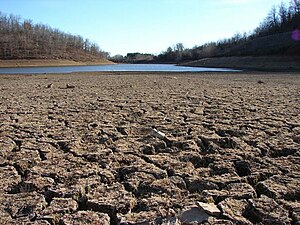
Drought is when a landscape does not receive enough fresh water (from rain, ice melt, or other sources). Water conservation is needed before and during a drought.
Droughts have severe economic, health, and social effects due to disruption of crop / food production, drinking water supply, and other uses of water. Loss of plant/vegetation cover from droughts also contributes to soil erosion from wind and from water when rain does occur.
Over the past few decades, drought has contributed to widespread famine, social disruption, and warfare in many developing countries, especially in Africa.
Most researchers expect droughts to become more common over the coming decades due to global climate change.
Long-term drought leads to desertification.
Effects of drought can be mitigated in various ways:
- Planting of drought-resistant crops
- Avoidance of water-intensive lifestyles (e.g., preferring "xeriscaping"W landscaping over grass lawns)
- Use of low-water appliances (e.g. low-flush toilets, low-flow shower heads)
- Avoiding erosion by contouring land; planting drought-resistant trees, bushes, or ground cover plants to stabilize soil; use of artificial or planted windbreaks.
- Recycling water through greywater systems.
- ...
News and comment[edit | edit source]
 First solar canal project is a win for water, energy, air and climate in California, The Conversation (Dec 22, 2022)
First solar canal project is a win for water, energy, air and climate in California, The Conversation (Dec 22, 2022)  Italy has declared a state of emergency in five northern regions surrounding the Po River amid the worst drought in 70 years, BBC News (Jul 05, 2022)
Italy has declared a state of emergency in five northern regions surrounding the Po River amid the worst drought in 70 years, BBC News (Jul 05, 2022)
2007 drought in Tennessee, USA[edit | edit source]
As of 2007 Orme, Tennessee was one of the hardest-hit communities in the drought-ridden southeastern United States, due to its dependence on two vulnerable water sources: a waterfall-fed creek and a natural spring that delivered up to 60,000 gallons/day (227,000 liters/day). These sources dried up to only 5,000 gallons/day (19,000 liters/day), not enough to pressurize the supply lines to the town's residents.
A temporary solution was arranged inwhich a 1961 firetruck[1] hauls water to the town from Alabama providing enough water to keep the system running for only three hours each day, from 18:00 to 21:00 local time.[1]
The mayor of Orme, Tony Reames, arranged a permanent solution in the form of a connection to the municipal system of the nearby community of Bridgeport, Alabama. In his words: "It's not a short-term solution. It is THE solution." The connection would be via a 2.5 mile (4 km) pipe between the two communities, paid for by an emergency grant of $377,590 from the USDA. The project was hoped to be completed by the end of November 2007.[2][2]
See also[edit | edit source]
External links[edit | edit source]
- Wikipedia:Drought
- 2006 Horn of Africa food crisisW
- List of faminesW
- Sahel droughtW
References[edit | edit source]
- ↑ Associated Press (2007-11-01). Tenn. town has water just 3 hours daily. MSNBC. Retrieved from http://www.msnbc.msn.com/id/21582319/?gt1=10547 on 2007-11-02.
- ↑ Bluestein, Greg (2007-11-01). Tennessee town has run out of water. Charlotte Observer. Retrieved from http://www.charlotte.com/nation/story/344047.html on 2007-11-01.